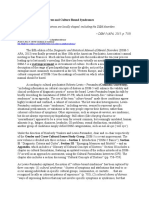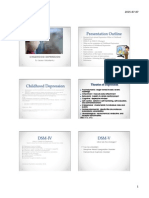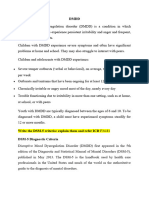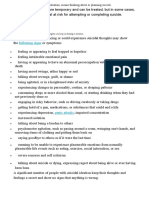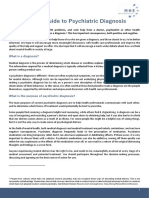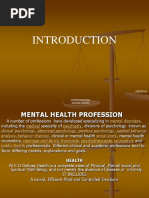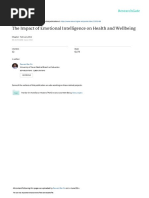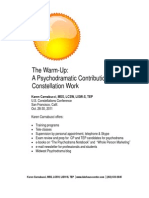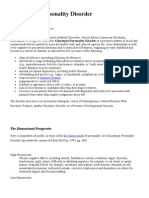Dramatic Personality Disorders: Antisocial, Borderline, Histrionic, and Narcissistic
Uploaded by
annthemsDramatic Personality Disorders: Antisocial, Borderline, Histrionic, and Narcissistic
Uploaded by
annthemsEccentric Personality Disorders: Paranoid, Schizoid,
Schizotypal
Individuals with these disorders often appear odd or
peculiar, and show these patterns by early adulthood
and in various contexts (e.g., work, home, social
situations).
An individual with Paranoid Personality Disorder
generally tends to interpret the actions of others as
threatening. This distrust and suspiciousness is
indicated by four (or more) of the following (from
DSM-IV, American Psychiatric Association, 1994)
1. suspects, without sufficient basis, that others
are exploiting, harming, or deceiving him or
her
2. is preoccupied with unjustified doubts about
the loyalty or trustworthiness of friends or
associates
3. is reluctant to confide in others because of
unwarranted fear that the information will be
used against him or her
4. reads hurtful or threatening meanings into
kind remarks or events
5. is unforgiving of insults or injuries
6. perceives attacks on his or her character or
reputation that are not apparent to others and
is quick to react angrily
7. has recurrent suspicions, without
justification, regarding faithfulness of
spouse or sexual partner
An individual with Schizoid Personality Disorder is
generally detached from social relationships, and
shows a narrow range of emotional expression in
various social settings. This pattern is indicated by
four (or more) of the following (from DSM-IV,
American Psychiatric Association, 1994)
1. neither desires nor enjoys close
relationships, including family relationships
2. often chooses activities that dont involve
other people.
3. has little interest in having sexual relations
with another person
4. enjoys few activities
5. lacks close friends other than immediate
family
6. appears indifferent to praise or criticism
7. shows emotional coldness, detachment, or
little emotional expression
A diagnosis of Schizoid Personality Disorder would
not be made if the criteria only occurred during the
course of a Pervasive Developmental Disorder (e.g.,
Autism).
A person with Schizotypal Personality Disorder is
uncomfortable in close relationships, has thought or
perceptual distortions, and peculiarities of behavior.
This disorder is indicated by five (or more) of the
following (from DSM IV, American Psychiatric
Association, 1994)
1. ideas of reference, i.e., believes that casual
and external events have a particular and
unusual meaning that is specific to him or
her
2. odd beliefs or magical thinking that
influences behavior and is inconsistent with
cultural norms (e.g., belief in superstitions
or clairvoyance, telepathy, or sixth sense
3. unusual perceptual experiences (e.g., hears a
voice murmuring his or her name; reports
bodily illusions)odd thinking and speech
(e.g., unusual phrasing, speech which is
vague, overly elaborate, and wanders from
the main point)
4. excessively suspicious thinking
5. inappropriate or constricted emotions
(reduced range and intensity of emotion)
6. behavior or appearance that is odd or
peculiar (e.g., unusual mannerisms, avoids
eye contact, wears stained, ill-fitting clothes)
7. lack of close friends or confidants other than
immediate family
8. excessive social anxiety that remains despite
familiarity with people and social situation.
The anxiety relates more to suspiciousness
about others motivations than to negative
judgments about self.
In addition to the exclusions described above, this
disorder would not be diagnosed if the pattern
described above only occurred during the course of
a Pervasive Developmental Disorder (e.g., Autism).
Dramatic Personality Disorders: Antisocial,
Borderline, Histrionic, and Narcissistic
Individuals with these disorders have intense,
unstable emotions, distorted self-perception, and/or
behavioral impulsiveness.
Individuals with Antisocial Personality Disorder
show a pervasive disregard for, and violation of, the
rights of others since age 15 years, as indicated by
three (or more) of the following (from DSM IV,
American Psychiatric Association, 1994)
1. repeated acts that are grounds for arrest
2. deceitfulness, i.e., repeated lying, use of
aliases, or conning others for personal profit
or pleasure
3. impulsiveness or failure to plan ahead
4. irritability and aggressiveness, such as
repeated physical fights or assaults
5. reckless disregard for the safety of self or
others
6. consistent irresponsibility, i.e., repeated
failure to sustain consistent work behavior
or honor financial obligations
7. lack of remorse, as indicated by indifference
to, or rationalizing having hurt, mistreated,
or stolen from another
4.
5.
6.
7.
8.
9.
To receive this diagnosis, an individual also needs
to be at least 18 years old, to show evidence of a
Conduct Disorder (which begins before age 15), and
to show antisocial behavior that does not only occur
during a Manic Episode or the course of
Schizophrenia.
Individuals with Borderline Personality Disorder
show a generalized pattern of instability in
interpersonal relationships, self-image, and
observable emotions, and significant impulsiveness.
This pattern begins by early adulthood, occurs in
various contexts, and is indicated by five (or more)
of the following (from DSM IV, American
Psychiatric Association, 1994)
1. frantic efforts (excluding suicidal or selfinflicted cuts or burns) to avoid real or
imagined abandonment
2. a pattern of intense and unstable
interpersonal relationships that may quickly
alternate between extremes of idealization
(the other person may be put on a
pedestal) and devaluation (the other
persons negative qualities are now
exaggerated)
3. identity disturbance: sudden and dramatic
shifts in self-image in terms of shifting
values (e.g., sexual identity, types of friends)
and vocational goals
impulsiveness in at least two areas that are
potentially harmful (e.g., spending, sex,
substance abuse, reckless driving, binge
eating, excluding suicidal or self-mutilating
behavior)
repeated suicidal behavior or threats, or selfinflicted cuts or burns (e.g., self-mutilating
behavior)
significant, sudden changes in mood and
observable emotion (e.g., intense periodic
sadness, irritability, or anxiety, usually
lasting a few hours and rarely lasting more
than a few days; extreme reactivity to
interpersonal stresses)
chronic feelings of emptiness; also may be
easily bored
inappropriate, intense anger or difficulty
controlling anger (e.g., frequent displays of
temper, constant anger, recurrent physical
fights)
temporary, stress-related psychosis
(symptoms such as paranoia or grossly
distorted body image)
Beginning in early adulthood, individuals with
Histrionic Personality Disorder often display
excessive emotionality and attention seeking in
various contexts. They tend to overreact to other
people, and are often perceived as shallow and selfcentered. This pattern is suggested by five (or more)
of the following (from DSM IV, American
Psychiatric Association, 1994)
1. discomfort in situations in which he or she is
not the center of attention
2. frequent, inappropriate, seductive or
provocative behavior in interpersonal
interactions
3. rapid shifts of emotions, and shallow
expression of emotions; emotions often
appear to be turned on and off too quickly
to be deeply felt
4. consistent use of physical appearance to
draw attention to self
5. excessively dramatic style of speech that
lacks detail; opinions are strongly presented,
but underlying reasons may be vague,
without supporting facts and details
6. self-dramatic, theatrical, and exaggerated
expression of emotion
7. easily influenced by others or circumstances
(e.g., fads)views relationships as more
intimate than they actually are
Individuals with Narcissistic Personality Disorder
often have a grandiose view of themselves, a need
for admiration, and a lack of empathy that begins by
early adulthood and is present in various situations.
These individuals are very demanding in their
relationships. This pattern is indicated by five (or
more) of the following (from DSM IV, American
Psychiatric Association, 1994)
1. has an inflated sense of self-importance
(e.g., exaggerates achievements and talents,
expects to be recognized as superior without
corresponding achievements)
2. is overly concerned with fantasies of
unlimited success, power, brilliance, beauty,
or ideal love
3. believes that he or she is special and
unique and can only be understood by, or
should associate with, other special or highstatus people (or institutions)
4. requires excessive admiration
5. has a sense of entitlement, i.e., unreasonable
expectations of very positive treatment or
automatic compliance with his or her
expectations
6. takes advantage of others to achieve his or
her own ends
7. lacks empathy
8. is unwilling to identify with the feelings and
needs of others
9. is often jealous of others or believes that
others are jealous of him or her
10. shows arrogant or domineering behaviors or
attitudes
Anxious Personality Disorders: Avoidant,
Dependent, Obsessive-Compulsive
Individuals with these disorders often appear
anxious or fearful, and like the other personality
disorders, the generalized patterns described below
typically begin in early adulthood, and are present
in various contexts.
An individual with Avoidant Personality Disorder
typically is socially inhibited, feels inadequate, and
is oversensitive to criticism, as indicated by four (or
more) of the following (from DSM IV, American
Psychiatric Association, 1994)
1. avoids work-related activities that involve
much social contact, because of fears of
criticism, disapproval, or rejection
2. is unwilling to get involved with people
unless certain of being liked
3. fears of shame or ridicule lead to excessive
shyness within intimate relationships
4. is overly concerned with criticism and
rejection in social situations
5. is inhibited in new social situations because
of feelings of inadequacy
6. views self as socially incompetent,
personally unappealing, or inferior to others
7. unusually reluctant to take personal risks or
do new activities because of fear of
embarrassment
A person with Dependent Personality Disorder
shows an extreme need to be taken care of that leads
to fears of separation, and passive and clinging
behavior. This disorder is indicated by five (or
more) of the following (from DSM IV, American
Psychiatric Association, 1994)
1. difficulty making daily decisions without an
excessive amount of advice and reassurance
from others
2. needs others to assume responsibility for
most major areas of his or her life
3. difficulty voicing disagreement with others
because of fear of loss of support or
approval (excluding realistic fears of
punishment)
4. difficulty starting projects or doing things on
his or her own (because of little selfconfidence in judgment or abilities, rather
than a lack of motivation or energy)
5. excessively attempts to obtain support from
others such that he or she volunteers to do
unpleasant tasks
6. feels uncomfortable or helpless when alone
because of exaggerated fears of being unable
to care for himself or herself
7. urgently seeks another relationship as a
source of support when a close relationship
ends
8. overly worried about being left to take care
of himself or herself
An individual with Obsessive Compulsive
Personality Disorder is preoccupied with
orderliness, perfectionism, and control at the
expense of flexibility, openness, and efficiency. This
pattern is indicated by four (or more) of the
following (from DSM IV, American Psychiatric
Association, 1994)
1. is overly concerned with details, rules, lists,
order, organization, or schedules such that
the major point of the activity is lost
2. is unable to complete a project because his
or her own overly strict standards are not
met
3. excessive emphasis on work and
productivity such that leisure activities and
friendships are devalued (not accounted for
by obvious economic need)
4. is overly conscientious and inflexible about
issues involving morality, ethics, or values
(not accounted for by cultural or religious
identification)
5. is unable to throw out worn-out or worthless
objects despite lack of emotional value
6. is reluctant to delegate tasks or work with
others unless they agree to exactly his or her
way of doing things
7. adopts a stingy spending style toward both
self and others; money is seen as something
to be gathered for future catastrophes
8. rigidity and stubbornness
There also is a diagnosis known as Personality
Disorders Not Otherwise Specified, which is
separate from the above three groups of disorders.
This diagnosis would be given for disturbed
personality functioning that does not meet criteria
for any specific Personality Disorder, but which
leads to distress or harm in one or more important
areas of functioning (e.g., social or work-related).
The clinician also may give this diagnosis if a
specific personality disorder that is not included in
the DSM IV Classification seems to apply to an
individual (e.g., depressive personality disorder, or
passive-aggressive personality disorder; DSM IV,
American Psychiatric Association, 1994).
You might also like
- Attitudes Towards Homosexuality in 29 NationsNo ratings yetAttitudes Towards Homosexuality in 29 Nations8 pages
- Pleasant Events, Activity Schedules, and Depressions PDFNo ratings yetPleasant Events, Activity Schedules, and Depressions PDF5 pages
- Inpatient Versus Outpatient Care, Partial Hospitalisation and Wait-List For People With Eating Disorders (Protocol)No ratings yetInpatient Versus Outpatient Care, Partial Hospitalisation and Wait-List For People With Eating Disorders (Protocol)26 pages
- L3 Chap 7 Clinical Assessment and Diagnosis100% (1)L3 Chap 7 Clinical Assessment and Diagnosis11 pages
- Cultural Concepts of Distress and Culture Bound SyndromesNo ratings yetCultural Concepts of Distress and Culture Bound Syndromes9 pages
- SAMPLE-Psych Assessment Elements & Histroy Taking Questions100% (1)SAMPLE-Psych Assessment Elements & Histroy Taking Questions5 pages
- Clinical Interview - Components and Basic SkillsNo ratings yetClinical Interview - Components and Basic Skills24 pages
- Childhood Depression Presentation OutlineNo ratings yetChildhood Depression Presentation Outline7 pages
- Rorschach (Challenge, Scoring, Interpretation) 2No ratings yetRorschach (Challenge, Scoring, Interpretation) 22 pages
- FINAL - Addressing Grief in Children - Infographic FlyerNo ratings yetFINAL - Addressing Grief in Children - Infographic Flyer1 page
- 03-2023SML Goodman Adult ADHD Slides 230922 195917100% (1)03-2023SML Goodman Adult ADHD Slides 230922 19591755 pages
- Disruptive Mood Dysregulation Disorder (DMDD)No ratings yetDisruptive Mood Dysregulation Disorder (DMDD)30 pages
- 2.symptoms and Signs of Psychiatric Disorders33% (3)2.symptoms and Signs of Psychiatric Disorders53 pages
- Clinical Picture of Antisocial Personality DisorderNo ratings yetClinical Picture of Antisocial Personality Disorder5 pages
- Free Download PDF Clinical Reasoning and Decision-Making in Psychiatry-2_The_Approach_to_Diagnostic_AmbiguityNo ratings yetFree Download PDF Clinical Reasoning and Decision-Making in Psychiatry-2_The_Approach_to_Diagnostic_Ambiguity4 pages
- Child Psychiatry - Assessment and TestingNo ratings yetChild Psychiatry - Assessment and Testing24 pages
- Psychodiagnostics and Psychological Assessment0% (1)Psychodiagnostics and Psychological Assessment4 pages
- Depression in Children Diagnostic Criteria - Epocrates OnlineNo ratings yetDepression in Children Diagnostic Criteria - Epocrates Online3 pages
- Attention Deficit Hyper-Activity Disorders (ADHD) : Prepare By: Jumana AlmomaniNo ratings yetAttention Deficit Hyper-Activity Disorders (ADHD) : Prepare By: Jumana Almomani30 pages
- PSY 3410 Autism Spectrum Disorders & Intellectual DisabilityNo ratings yetPSY 3410 Autism Spectrum Disorders & Intellectual Disability33 pages
- American Psychological Association (APA) Referencing StyleNo ratings yetAmerican Psychological Association (APA) Referencing Style14 pages
- DSM 5 TR Made Easy The Clinician s Guide to Diagnosis 1st Edition Morrison - Quickly download the ebook to never miss important content100% (1)DSM 5 TR Made Easy The Clinician s Guide to Diagnosis 1st Edition Morrison - Quickly download the ebook to never miss important content60 pages
- Stages of Substance Use and Suggested Interventions: Bright Futures Tool For ProfessionalsNo ratings yetStages of Substance Use and Suggested Interventions: Bright Futures Tool For Professionals2 pages
- Chapter 1 Developmental PsychopathologyNo ratings yetChapter 1 Developmental Psychopathology30 pages
- Icd 10 & 11 Comparison - My Ignou Case 1No ratings yetIcd 10 & 11 Comparison - My Ignou Case 140 pages
- Lecture 5-Mood disordersPDF - 240228 - 203457100% (1)Lecture 5-Mood disordersPDF - 240228 - 20345747 pages
- Abnormal Psychology Anxiety Disorders - SNo ratings yetAbnormal Psychology Anxiety Disorders - S38 pages
- NSW Department of Health 2004 Suicide Risk Assessment and Management Protocols General Community Health Service100% (1)NSW Department of Health 2004 Suicide Risk Assessment and Management Protocols General Community Health Service20 pages
- Cross-Cultural Conference Presentation 02072018 StandardNo ratings yetCross-Cultural Conference Presentation 02072018 Standard33 pages
- Proposed Treament Plan For The Case StudyNo ratings yetProposed Treament Plan For The Case Study5 pages
- Cultural Empathy: Description of The Multicultural Personality Questionnaire (MPQ)No ratings yetCultural Empathy: Description of The Multicultural Personality Questionnaire (MPQ)5 pages
- Trauma Survivor's Self-Help Guidebook Empowering Strategies For Healing And Converting Pain Into Strength And ResilienceFrom EverandTrauma Survivor's Self-Help Guidebook Empowering Strategies For Healing And Converting Pain Into Strength And ResilienceNo ratings yet
- Cross-Country Determinants of Life Satisfaction. Exploring Different Determinants Across Groups in StudyNo ratings yetCross-Country Determinants of Life Satisfaction. Exploring Different Determinants Across Groups in Study17 pages
- The Industrial Revolution-Lecture Notes: I. A Pre-Industrial SocietyNo ratings yetThe Industrial Revolution-Lecture Notes: I. A Pre-Industrial Society4 pages
- Gim Wali: This Is An Example of Market Exchange Since There Is Pricing and The Laws ofNo ratings yetGim Wali: This Is An Example of Market Exchange Since There Is Pricing and The Laws of1 page
- Ricardo S. Inton and Jose F. Tiburcio For Petitioners. Hermin E. Arceo For Private RespondentsNo ratings yetRicardo S. Inton and Jose F. Tiburcio For Petitioners. Hermin E. Arceo For Private Respondents4 pages
- Zafar & Khalily-Urdu Translation Process - 2No ratings yetZafar & Khalily-Urdu Translation Process - 21 page
- Message in The Music: Do Lyrics Influence Well-Being? Message in The Music: Do Lyrics Influence Well-Being?No ratings yetMessage in The Music: Do Lyrics Influence Well-Being? Message in The Music: Do Lyrics Influence Well-Being?45 pages
- Introduction To Psychiatric Nursing: Prepared By: Jacqueline Arah Lim Tario R.NNo ratings yetIntroduction To Psychiatric Nursing: Prepared By: Jacqueline Arah Lim Tario R.N82 pages
- Humanistic Psychology & Carl Rogers' Theory of PersonalityNo ratings yetHumanistic Psychology & Carl Rogers' Theory of Personality2 pages
- The Impact of Emotional Intelligence On Health and WellbeingNo ratings yetThe Impact of Emotional Intelligence On Health and Wellbeing23 pages
- The Warm-Up: How Psychodrama and Systemic Constellation Work Can Work Together - US ConstellationsNo ratings yetThe Warm-Up: How Psychodrama and Systemic Constellation Work Can Work Together - US Constellations9 pages
- Trauma FocusedCognitive BehavioralTherapy (TF CBT)No ratings yetTrauma FocusedCognitive BehavioralTherapy (TF CBT)2 pages
- NIH Public Access: DSM-5: Disruptive Mood Dysregulation DisorderNo ratings yetNIH Public Access: DSM-5: Disruptive Mood Dysregulation Disorder11 pages
- Abdul Wakhid PENERAPAN TERAPI LATIHAN KETRAMPILAN SOSIAL PADA KLIEN ISOL PDFNo ratings yetAbdul Wakhid PENERAPAN TERAPI LATIHAN KETRAMPILAN SOSIAL PADA KLIEN ISOL PDF15 pages
- Adler Individual Psychology - Research Paper - Siedlecki-Adler - Psyc341 PDFNo ratings yetAdler Individual Psychology - Research Paper - Siedlecki-Adler - Psyc341 PDF15 pages
- The TAPS Project. 8: Design of The Research Study On The Long-Stay PatientsNo ratings yetThe TAPS Project. 8: Design of The Research Study On The Long-Stay Patients7 pages
- Mental Diseases: M Ángeles Martínez Quero Daniel Maján Jiménez Antonio Marco Mora Hervás Sandra Paz LópezNo ratings yetMental Diseases: M Ángeles Martínez Quero Daniel Maján Jiménez Antonio Marco Mora Hervás Sandra Paz López12 pages
- Pleasant Events, Activity Schedules, and Depressions PDFPleasant Events, Activity Schedules, and Depressions PDF
- Inpatient Versus Outpatient Care, Partial Hospitalisation and Wait-List For People With Eating Disorders (Protocol)Inpatient Versus Outpatient Care, Partial Hospitalisation and Wait-List For People With Eating Disorders (Protocol)
- Cultural Concepts of Distress and Culture Bound SyndromesCultural Concepts of Distress and Culture Bound Syndromes
- SAMPLE-Psych Assessment Elements & Histroy Taking QuestionsSAMPLE-Psych Assessment Elements & Histroy Taking Questions
- FINAL - Addressing Grief in Children - Infographic FlyerFINAL - Addressing Grief in Children - Infographic Flyer
- 03-2023SML Goodman Adult ADHD Slides 230922 19591703-2023SML Goodman Adult ADHD Slides 230922 195917
- Clinical Picture of Antisocial Personality DisorderClinical Picture of Antisocial Personality Disorder
- Free Download PDF Clinical Reasoning and Decision-Making in Psychiatry-2_The_Approach_to_Diagnostic_AmbiguityFree Download PDF Clinical Reasoning and Decision-Making in Psychiatry-2_The_Approach_to_Diagnostic_Ambiguity
- Depression in Children Diagnostic Criteria - Epocrates OnlineDepression in Children Diagnostic Criteria - Epocrates Online
- Attention Deficit Hyper-Activity Disorders (ADHD) : Prepare By: Jumana AlmomaniAttention Deficit Hyper-Activity Disorders (ADHD) : Prepare By: Jumana Almomani
- PSY 3410 Autism Spectrum Disorders & Intellectual DisabilityPSY 3410 Autism Spectrum Disorders & Intellectual Disability
- American Psychological Association (APA) Referencing StyleAmerican Psychological Association (APA) Referencing Style
- DSM 5 TR Made Easy The Clinician s Guide to Diagnosis 1st Edition Morrison - Quickly download the ebook to never miss important contentDSM 5 TR Made Easy The Clinician s Guide to Diagnosis 1st Edition Morrison - Quickly download the ebook to never miss important content
- Stages of Substance Use and Suggested Interventions: Bright Futures Tool For ProfessionalsStages of Substance Use and Suggested Interventions: Bright Futures Tool For Professionals
- NSW Department of Health 2004 Suicide Risk Assessment and Management Protocols General Community Health ServiceNSW Department of Health 2004 Suicide Risk Assessment and Management Protocols General Community Health Service
- Cross-Cultural Conference Presentation 02072018 StandardCross-Cultural Conference Presentation 02072018 Standard
- Cultural Empathy: Description of The Multicultural Personality Questionnaire (MPQ)Cultural Empathy: Description of The Multicultural Personality Questionnaire (MPQ)
- Trauma Survivor's Self-Help Guidebook Empowering Strategies For Healing And Converting Pain Into Strength And ResilienceFrom EverandTrauma Survivor's Self-Help Guidebook Empowering Strategies For Healing And Converting Pain Into Strength And Resilience
- Cross-Country Determinants of Life Satisfaction. Exploring Different Determinants Across Groups in StudyCross-Country Determinants of Life Satisfaction. Exploring Different Determinants Across Groups in Study
- The Industrial Revolution-Lecture Notes: I. A Pre-Industrial SocietyThe Industrial Revolution-Lecture Notes: I. A Pre-Industrial Society
- Gim Wali: This Is An Example of Market Exchange Since There Is Pricing and The Laws ofGim Wali: This Is An Example of Market Exchange Since There Is Pricing and The Laws of
- Ricardo S. Inton and Jose F. Tiburcio For Petitioners. Hermin E. Arceo For Private RespondentsRicardo S. Inton and Jose F. Tiburcio For Petitioners. Hermin E. Arceo For Private Respondents
- Message in The Music: Do Lyrics Influence Well-Being? Message in The Music: Do Lyrics Influence Well-Being?Message in The Music: Do Lyrics Influence Well-Being? Message in The Music: Do Lyrics Influence Well-Being?
- Introduction To Psychiatric Nursing: Prepared By: Jacqueline Arah Lim Tario R.NIntroduction To Psychiatric Nursing: Prepared By: Jacqueline Arah Lim Tario R.N
- Humanistic Psychology & Carl Rogers' Theory of PersonalityHumanistic Psychology & Carl Rogers' Theory of Personality
- The Impact of Emotional Intelligence On Health and WellbeingThe Impact of Emotional Intelligence On Health and Wellbeing
- The Warm-Up: How Psychodrama and Systemic Constellation Work Can Work Together - US ConstellationsThe Warm-Up: How Psychodrama and Systemic Constellation Work Can Work Together - US Constellations
- Trauma FocusedCognitive BehavioralTherapy (TF CBT)Trauma FocusedCognitive BehavioralTherapy (TF CBT)
- NIH Public Access: DSM-5: Disruptive Mood Dysregulation DisorderNIH Public Access: DSM-5: Disruptive Mood Dysregulation Disorder
- Abdul Wakhid PENERAPAN TERAPI LATIHAN KETRAMPILAN SOSIAL PADA KLIEN ISOL PDFAbdul Wakhid PENERAPAN TERAPI LATIHAN KETRAMPILAN SOSIAL PADA KLIEN ISOL PDF
- Adler Individual Psychology - Research Paper - Siedlecki-Adler - Psyc341 PDFAdler Individual Psychology - Research Paper - Siedlecki-Adler - Psyc341 PDF
- The TAPS Project. 8: Design of The Research Study On The Long-Stay PatientsThe TAPS Project. 8: Design of The Research Study On The Long-Stay Patients
- Mental Diseases: M Ángeles Martínez Quero Daniel Maján Jiménez Antonio Marco Mora Hervás Sandra Paz LópezMental Diseases: M Ángeles Martínez Quero Daniel Maján Jiménez Antonio Marco Mora Hervás Sandra Paz López








